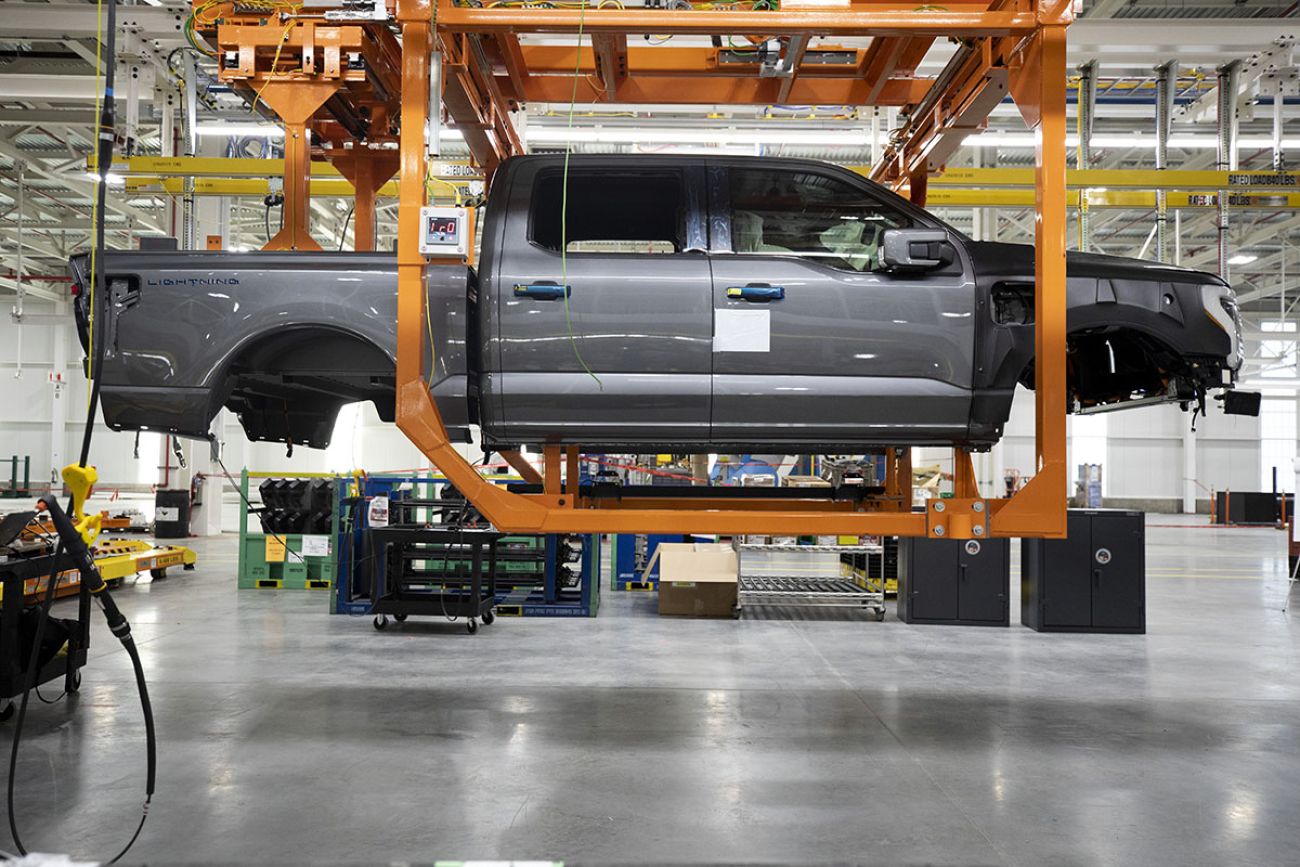Here are the electric vehicles eligible for the revised $7,500 tax credit


- The rules for tax credits for electric vehicles tightened Monday, as only 10 models now qualify for the full $7,500
- The change reflects the U.S. goal of moving production of EVs to this country
- More models are likely to qualify in the next few years as automakers add capacity in the North America
The federal government still wants to encourage people to buy electric vehicles through a $7,500 tax credit, but starting on Tuesday fewer models will qualify for it.
The incentive change — which takes effect on vehicles purchased as of Tuesday — reflects both more stringent environmental goals and the desire for more North American vehicle manufacturing as the auto industry shifts from gas-fueled vehicles to electric.
Guidelines released Monday by the U.S. Department of Energy follow last year’s $738 billion Inflation Reduction Act (IRA), which set climate goals and targeted U.S. energy security by funding supply chain moves for things like EV batteries, solar panels and microchips to the U.S. from China.
Related:
- Romeo embraced its Ford engine plant. After closure, an uncertain future
- Mackinac Island ferry switching to electric power
- Michigan voters are skeptical of EVs and the value of college in new poll
The new tax credit guidelines allow a $3,750 subsidy for each of two requirements a vehicle meets, including whether critical minerals in EV batteries— like lithium, nickel, graphite and copper — are extracted or processed in the United States, or in a country that has a free-trade agreement with the U.S. The battery component requirement mandates that a portion of the battery is made or assembled in North America. Both requirements face further tightening over the next five years as the government further incentivizes production changes.
With the IRA, the U.S. is investing $7.5 billion in EV charging networks, $10 billion in clean transportation to reduce emissions, and over $7 billion in EV battery components, critical minerals, and materials.
The goal, according to the White House, is to achieve net-zero auto emissions by 2050, something that “is creating good-paying manufacturing and installation jobs on the way.”
EVs made up about 6 percent of new U.S. car sales in 2022, double from a year earlier, according to Barron’s. Thirty EV models sold more than 1,000 units in the U.S. in 2022, up from 18 models hitting that mark in 2021.
Several of the models on the subsidy eligibility list released on Monday are built in Michigan, including at General Motors’ Factory One in Hamtramck and Ford Motor Co.’s Rouge Electric Vehicle Center.
To qualify for the tax credit, the vehicle must be purchased new and can’t cost more than $80,000 for vans, sport utility vehicles and pickup trucks, or $55,000 for other vehicles. In 2022, the typical EV sold for about $60,000.
Here are more things to know about the tax credit:
These models are now eligible for the full $7,500 tax credit:
Ford
- 2022-2023 Ford F-150 Lightning (standard and extended range)
- 2023 Lincoln Aviator Grand Touring
General Motors
- 2022-2023 Chevrolet Bolt
- 2022-2023 Chevrolet Bolt EUV
- 2023-2024 Cadillac LYRIQ
- 2024 Chevrolet Silverado EV
- 2024 Chevrolet Blazer EV
- 2024 Chevrolet Equinox EV
Stellantis
- 2022-2023 Chrysler Pacifica PHEV (plug-in hybrid electric vehicle)
- 2022-2023 Jeep Wrangler PHEV 4xe
- 2022-2023 Jeep Grand Cherokee PHEV 4xe
Tesla
- 2022-2023 Tesla Model 3 Performance
- 2022-2023 Tesla Model Y AWD (all-wheel drive)
- 2022-2023 Tesla Model Y Long Range AWD
- 2022 Tesla Model Y Performance
These models are now eligible for a $3,750 tax credit for meeting either the battery or critical mineral requirement:
Ford
- 2022 Ford e-Transit
- 2022-2023 Ford Mustang Mach-E (standard and extended range)
- 2022 Ford Escape Plug-in Hybrid
- 2022 Lincoln Corsair Grand Touring
Stellantis
- 2022-2023 Jeep Wrangler PHEV 4xe
- 2022-2023 Jeep Grand Cherokee PHEV 4xe
Tesla
- 2022-2023 Tesla Model 3 Standard Range RWD
What about other vehicles?
Nine models now do not qualify for the tax credit, including models from Hyundai and Nissan.
However, the race to build EV-related factories in the U.S. is going to change that. Hyundai, for example, is building a $5.5 billion EV-dedicated factory in Georgia. By the time it opens in the first half of 2025, its models should qualify for any U.S.-centered tax credits. Nissan is planning to build EVs in Mississippi, where it is retooling an existing factory.
Toyota also plans to unveil new EVs in the coming years as it shifts to EV production at its Kentucky factory in 2025, using batteries that it makes in North Carolina.
The automaker — which does extensive R&D in Washtenaw County — expects a fast production ramp-up, going from 10,000 electric SUVs per month in 2025 to 200,000 EVs over the following year.
What about state incentives?
Michigan does not yet offer a tax credit for EVs.
However, Governor Gretchen Whitmer proposed a $2,000 new EV rebate in her State of the State address and a $500 rebate for at-home charging infrastructure. Neither has been approved.
The U.S Department of Energy tracks state-level incentives, which can be for individuals or businesses. Some are provided by utility companies.
Emissions rule changes
The new EV tax credit criteria follows last week’s announcement by the Environmental Protection Agency as it seeks to cut tailpipe emissions standards by an average of 13 percent per year for cars and light duty trucks — or about 75 percent less than a car today.
In making that change, the EPA said it expects EVs to be 60 percent of the new vehicle market by 2030 — compared to industry projections of 22 percent.
The difference in market share prediction makes many skeptical that the EV industry will leap forward that quickly. Consumers are evenly divided between support and opposition for EVs, according to a recent poll by the Detroit Regional Chamber.
“There is nothing in the EPA’s proposed rules that indicate consumers will voluntarily and dramatically change their preferences within the next five years,” said Patrick Anderson of Anderson Economic Group in East Lansing after the EPA announcement.
The EPA’s scenarios are “not a valid factual basis for the feasibility of a ten-fold increase in the sales and production of electric cars,” Anderson said.
How to claim the credit
The credit comes after you file for it with your taxes for the year you purchase the vehicle. It is available to individuals and their businesses. The vehicle must be bought for your own use instead of resale, and it must be used in the U.S.
Income limits are $150,000 for a single filer or $300,000 for married couples filing jointly.
The credit is nonrefundable, meaning it will only be subtracted from what you owe in taxes — you won’t get more back than that, and you can’t apply excess credit in subsequent years.
More details are available from the Internal Revenue Service.
Business Watch
Covering the intersection of business and policy, and informing Michigan employers and workers on the long road back from coronavirus.
- About Business Watch
- Subscribe
- Share tips and questions with Bridge Business Editor Paula Gardner
Thanks to our Business Watch sponsors.
Support Bridge's nonprofit civic journalism. Donate today.
See what new members are saying about why they donated to Bridge Michigan:
- “In order for this information to be accurate and unbiased it must be underwritten by its readers, not by special interests.” - Larry S.
- “Not many other media sources report on the topics Bridge does.” - Susan B.
- “Your journalism is outstanding and rare these days.” - Mark S.
If you want to ensure the future of nonpartisan, nonprofit Michigan journalism, please become a member today. You, too, will be asked why you donated and maybe we'll feature your quote next time!


